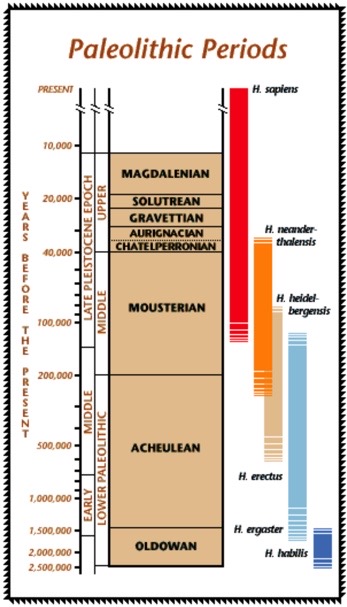
Shorthistory.org |
Stone Age Technologies
Jean Vaucher (August 2022) |
- Index
Introduction
Use of tools use is an indication of intelligence. Our smart relatives, the apes, have long used stones to crack nuts and sticks to fish for termites [Video] ; but around 2,5 Mya (million years ago), Homo habilis, our ancestor, went a step further and started to make tools, namely getting sharp edges on stones by splitting them apart. These modified stones were useful in many ways, i.e. to cut meat from carcasses, fight off predators or dig for roots.
In addition, early man probably other materials like wood, animal skins, bone and vegetable fibers; but, these decomposed long ago, leaving the stone implements to provide the label "Stone Age" to this first intelligent era.
Thereafter, within the Homo genus, genetic selection will be helped (if not replaced) by the addition of technology and communication. For example, with sharp tools and better weapons, Man will rise to the top of the food chain without the necessity of evolving claws. Later, with fire and the use of animal skins as clothing, we will be able to survive in northern climates without evolving body fat and fur.
Here we are mainly interested in the Old Stone Age (also called Paleolithic), before 10,000 BCE when the Ice Ages ended. Initially, progress was painfully slow, mainly because of low population, ~ 50,000 world-wide over the period, and lack of language to pass on knowledge. As shown on the image at right, the first species, Habilis, Erectus and Neanderthals, develop their own "industry" each lasting hundreds of thousands of years.
Then, around 100 Kya, Homo Sapiens appears in Africa with a better organized brain that permits abstract thought and a mutation that allows speech. Around 50 Kya, Sapiens leaves Africa and spreads into the temperate regions of Europe, Asia and beyond into Australia. This period, called the Upper Stone Age period, triggers the rapid succession in technologies which replace the Neanderthal's "Mousterian"".
Progress will accelerate even more during the Mesolithic Period after the Ice Age ends and global temperatures rise. In short order, our hunter/gatherers will migrate into northern Eurasia and cross into the Americas. They will also learn to domesticate plants and tame animals and turn to farming. This is the beginning of civilization; and the end of the Paleolithic.
In this section, we concentrate on early technologies from our hunter-gatherer period. First, we look at stone tools; then, based on observation of recent "primitive" tribes we consider other materials that early hominins probably invented before they settled into agrarian life.
Note: Thanks to the Internet, there now exists many videos demonstrating Stone Age techniques. A good example is the web site just below from the Ashmolean Museum at Oxford University.
Living in the Stone Age, sample of their 12 videos
References
- Paleolithic Timeline, 15 m. video
- Mesolithic Timeline, 19 m. video




